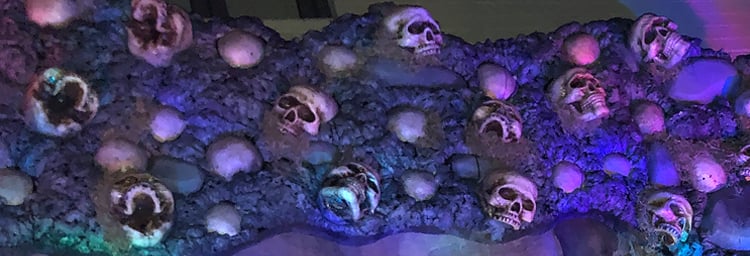For some people – Halloween is the most important holiday of the year. It’s the time of year to pull out all the stops and celebrate the haunted and the macabre. Such is the case for one residence in Washington D.C. who opened up their home to host what they’re calling the “Chesterfield Circus.” As guests enter this haunted home-attraction, they walk through an archway of foam skulls that is coated/protected by a variety of Rosco Scenic Products. Below, Production Designer Betsy Zuck and Master Scenic Artist Lisa Knewberry explain how they assembled their durable Halloween scenery.
Scott Roewer from The Organizing Agency in Washington D.C. had designed and built a catacomb entryway as a Halloween project for a local client that was hosting a haunted event at their house. These catacomb wall coverings were comprised of pink insulation foam carved to look like rocks, along with pre-painted skulls that were made of white bead foam. Scott reached out looking for advice to make the wall coverings more durable.
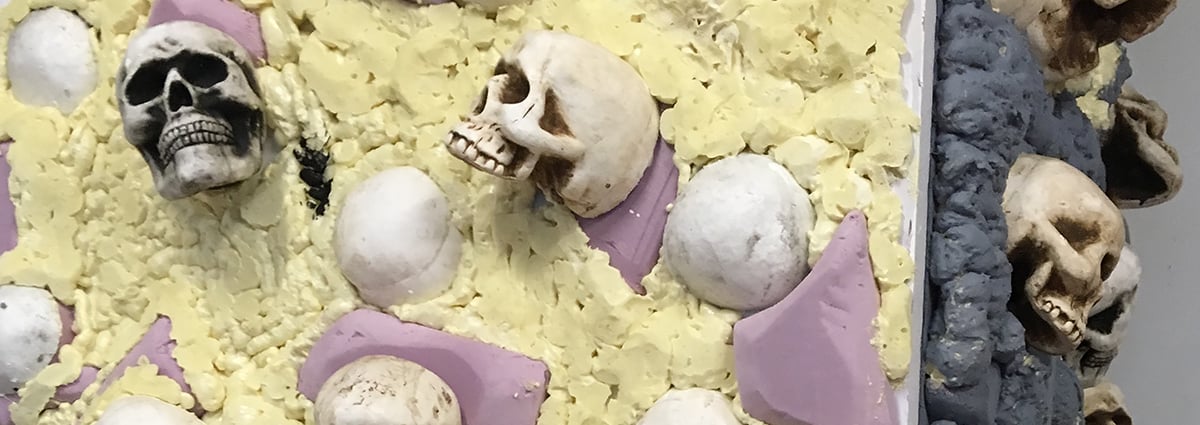 The catacomb entryway needed to be coated with something that would help it withstand transport in a moving van, installation at the venue, public interaction, weeks of outdoor weather, storage for a year, and re-use the following season. The entryway also needed to be ready for load-in in a week’s time. We immediately thought of Rosco and wondered which of their products were best suited for the job. This is when we were introduced to Jenny Knott, who graciously accepted all of our questions and described how she might go about creating samples for the project. Her most helpful suggestion was experimenting with Kaolin Clay and a variety of Rosco Scenic Products.
The catacomb entryway needed to be coated with something that would help it withstand transport in a moving van, installation at the venue, public interaction, weeks of outdoor weather, storage for a year, and re-use the following season. The entryway also needed to be ready for load-in in a week’s time. We immediately thought of Rosco and wondered which of their products were best suited for the job. This is when we were introduced to Jenny Knott, who graciously accepted all of our questions and described how she might go about creating samples for the project. Her most helpful suggestion was experimenting with Kaolin Clay and a variety of Rosco Scenic Products.
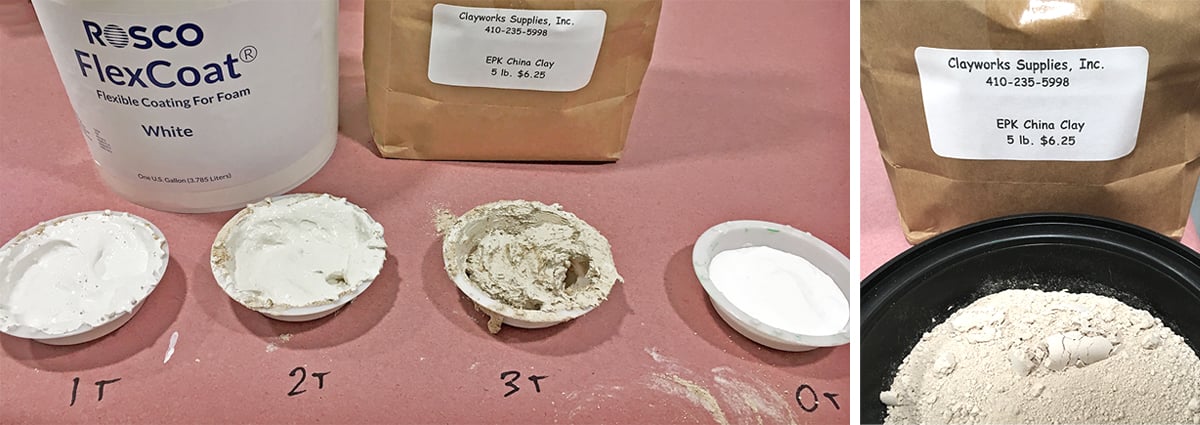 Our biggest question was how the Kaolin Clay (aka China Clay) would mix with the Rosco products and what the ratios needed to be. A coat of exterior latex had already been applied to some of the foam and we found it to be fairly resilient, but the single coat of paint was not as strong as we would’ve preferred. Taking Jenny’s advice, we created two test boards that examined the performance of the Kaolin Clay – one mixed into Rosco FoamCoat™ and the into Rosco FlexCoat®.
Our biggest question was how the Kaolin Clay (aka China Clay) would mix with the Rosco products and what the ratios needed to be. A coat of exterior latex had already been applied to some of the foam and we found it to be fairly resilient, but the single coat of paint was not as strong as we would’ve preferred. Taking Jenny’s advice, we created two test boards that examined the performance of the Kaolin Clay – one mixed into Rosco FoamCoat™ and the into Rosco FlexCoat®.
After testing, we found that, due to the multiple types of foam used in this wall, the FlexCoat provided the desired coverage and flexibility required for this particular project. We also determined that it was better to mix the FlexCoat with the exterior latex house paint in order to provide the viscosity needed to spread the clay properly. Too much Kaolin Clay, we found, made the resulting blend difficult to coat the foam entirely. The final coat was an application of Rosco Premiere Clear™ – Satin for durability, which also provided a nice shadow wash that accentuated the dimension before a dry brush technique pulled out the highlights.
We delivered the samples and recommendations to the project where Lisa was able to implement the over-all treatments. Below are her process notes as she mixed the recommended batches for the final recipes of their durable Halloween scenery:
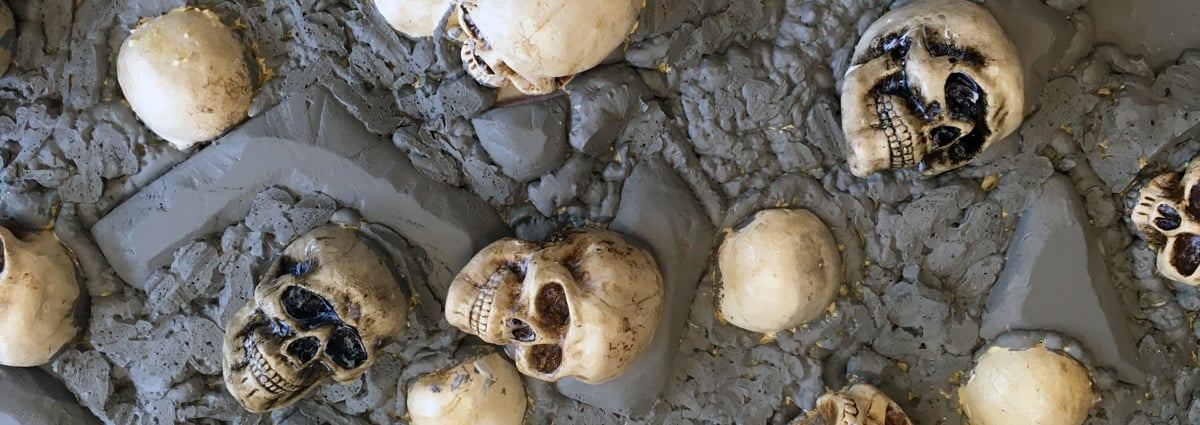
Base Coat:
Combine 1 gallon of Rosco FlexCoat with 1 gallon of grey exterior latex paint.
Add 4 Tablespoons of Rosco Supersaturated Paynes Grey and mix well.
Add 2.5 scant cups of powdered Kaolin Clay and mix thoroughly.
Apply to entire surface of the "stone" generously with brush, allowing to seep into all holidays and edging carefully around the skulls. Allow to dry for 24 hours.
Skull Finish:
Coat the surface of skulls generously with undiluted Rosco CrystalGel™ with brush. Allow to dry for 24 hours.
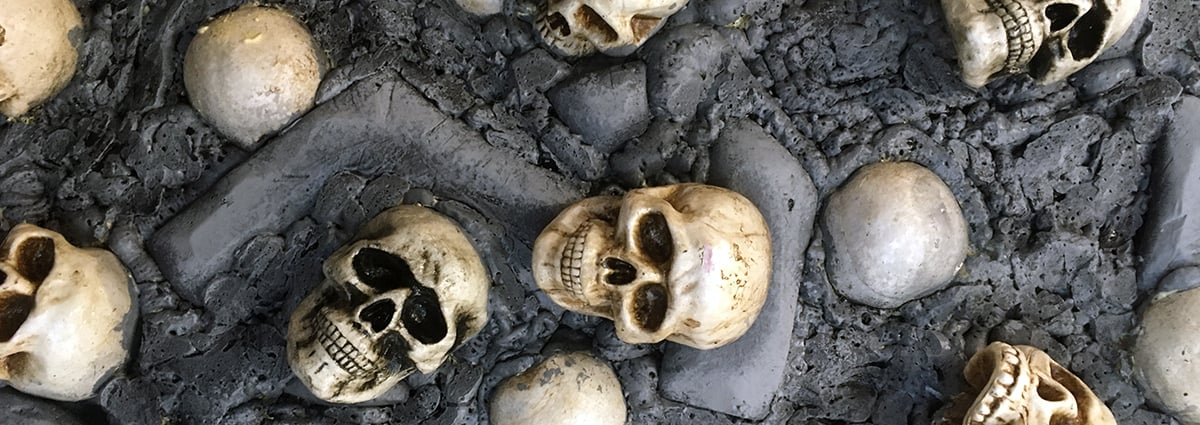
Wet Shadow Coat:
Mix 1/2 gallon of Rosco Premier Clear - Satin with 1/4-gallon matte black latex paint.
Add two Tablespoons Rosco Supersaturated Paynes Grey and mix well.
Dilute with approximately 1/2-gallon water and mix thoroughly.
Strain mix into floor sealer paint sprayer.
Lay scenic pieces flat on floor. Apply mix loosely with sprayer over entire "stone" surface avoiding skulls, allowing holidays to fill with darkness. Use clean sponge to lift any undesired excess spray on skulls.
Allow to dry in place completely 24-48 hours.
Finishing details:
Apply light grey latex paint highlights to stones as desired with a dry brush.
Apply Wet Shadow mix (see above) with a dry sponge to further darken any desired areas.
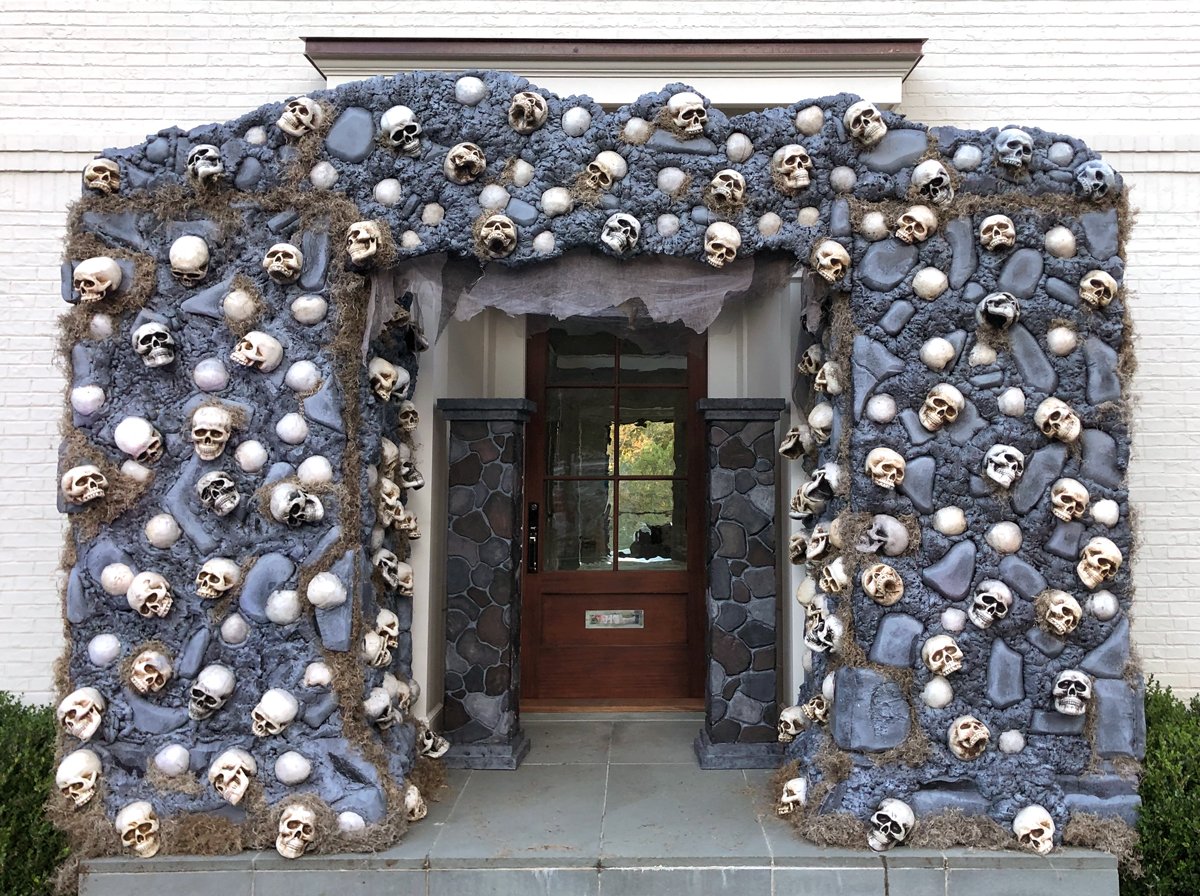 We were very pleased with the final results of this project and are happy to report that the catacomb walls endured transport and installation admirably and entirely intact. The combination of Kaolin Clay, FlexCoat, exterior latex paint, and Rosco Premier Clear not only provided a visual-depth to the scenery, but also the strength the scenery needed to survive the trip, the installation, visitor interactions, the outdoor elements, storage and re-installation next year for “Chesterfield Circus 2020” and beyond.
We were very pleased with the final results of this project and are happy to report that the catacomb walls endured transport and installation admirably and entirely intact. The combination of Kaolin Clay, FlexCoat, exterior latex paint, and Rosco Premier Clear not only provided a visual-depth to the scenery, but also the strength the scenery needed to survive the trip, the installation, visitor interactions, the outdoor elements, storage and re-installation next year for “Chesterfield Circus 2020” and beyond.
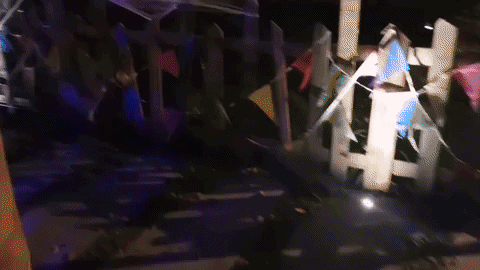
If you’d like to see more of Betsy Zuck and Lisa Knewberry’s scenic work, visit their websites:
Betsy - transmogrifydesigns.com
Lisa – lisaknewberry.com
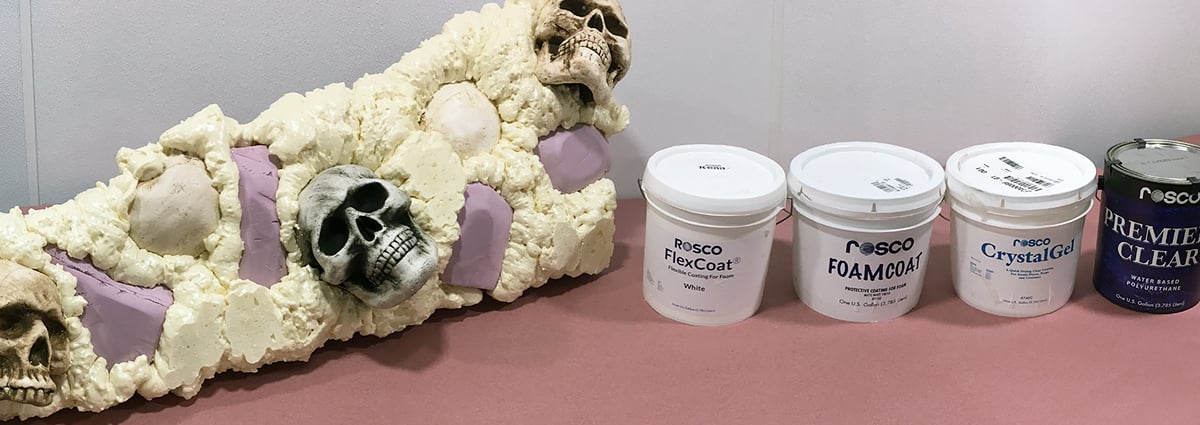
To learn more about the products Betsy and Lisa used to create their durable Halloween scenery: visit the Scenic Products Page on rosco.com.
UPDATE: The DC-area was hit hard by severe storms during the Halloween season of 2019. Despite being well-anchored to the ground, the strong winds lifted the skull wall and threw it about 50 yards. While much of the timber infractuctue snapped, and some of the skulls were cracked, the team at The Organizing Agnecy reported that all of the foam scenery survived intact - making it a relatively simple repair job.

